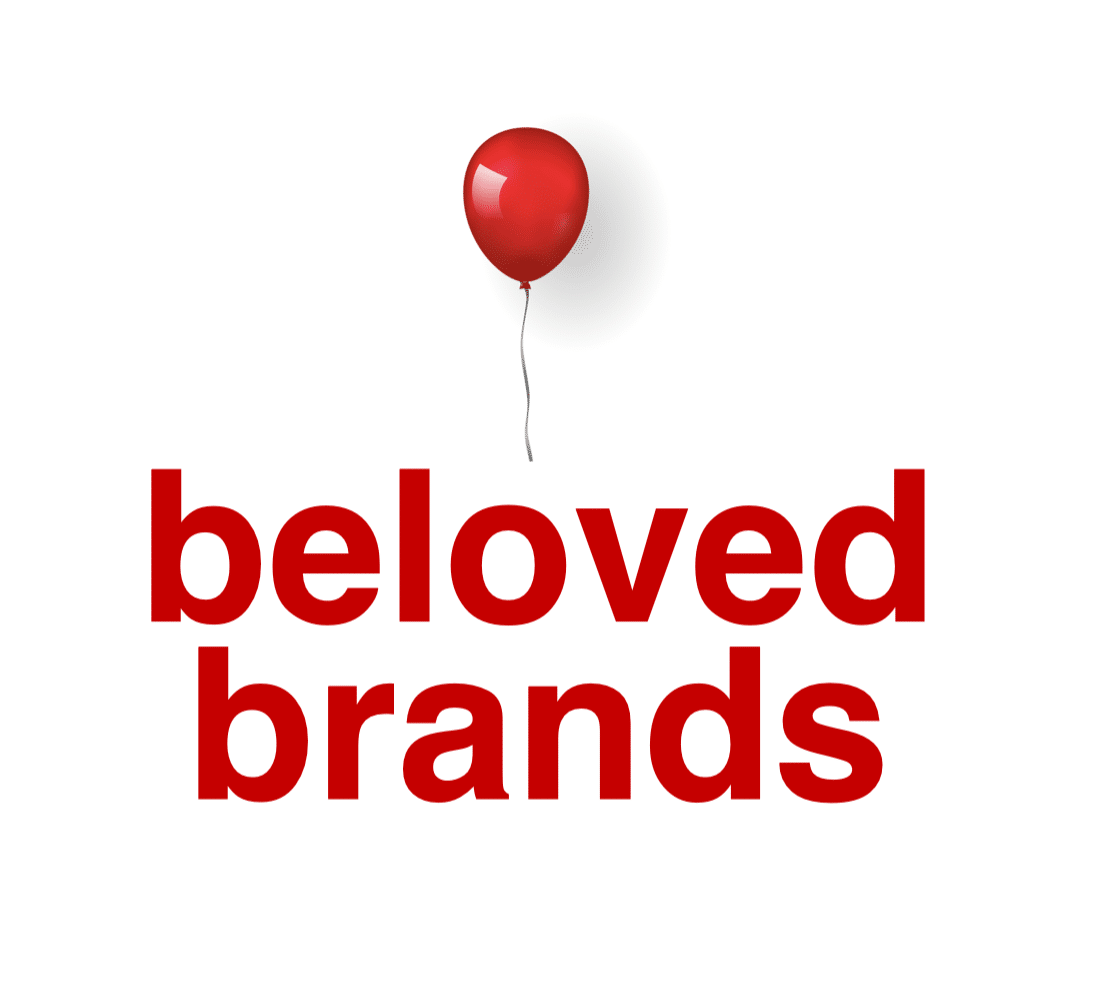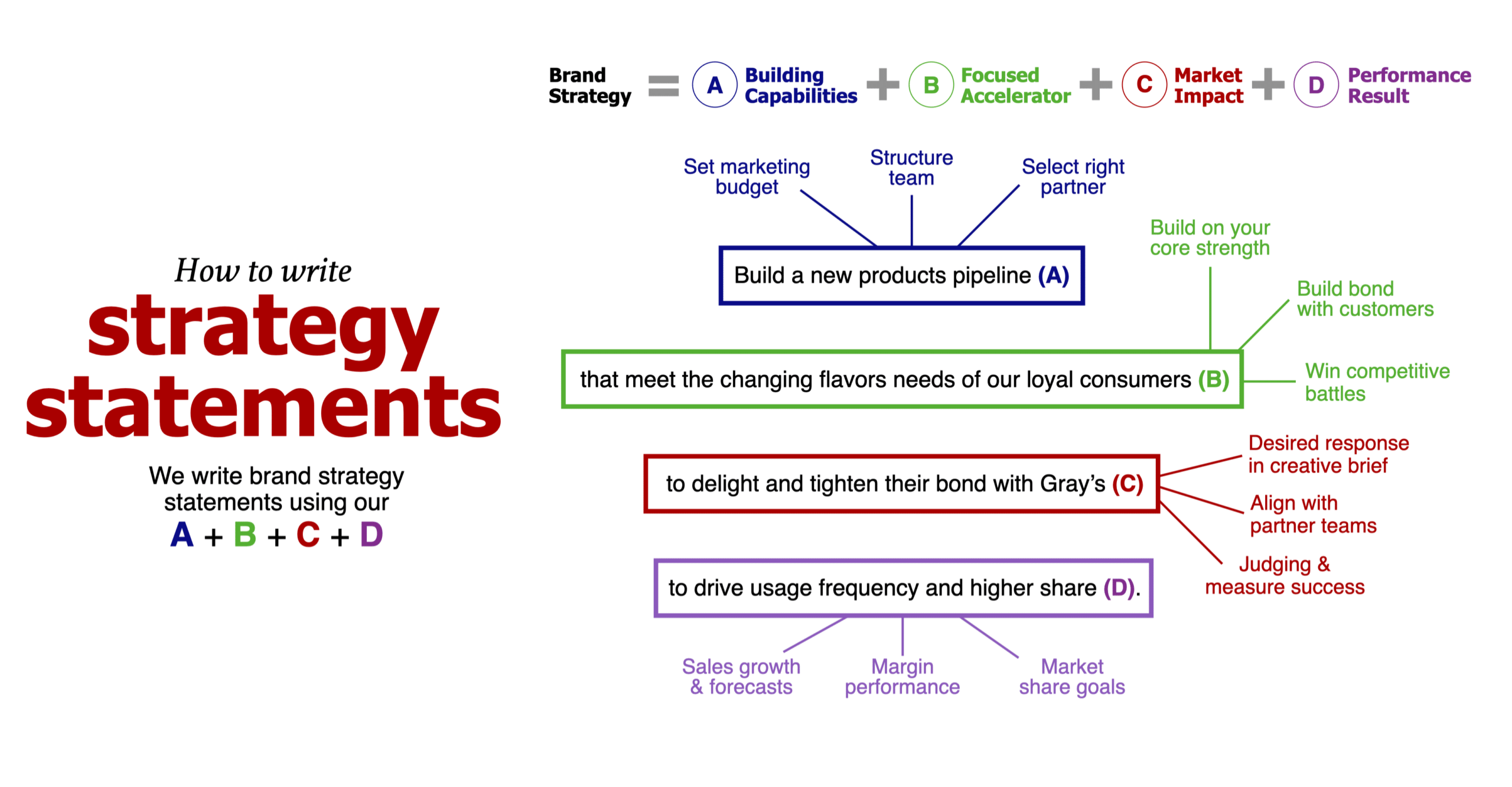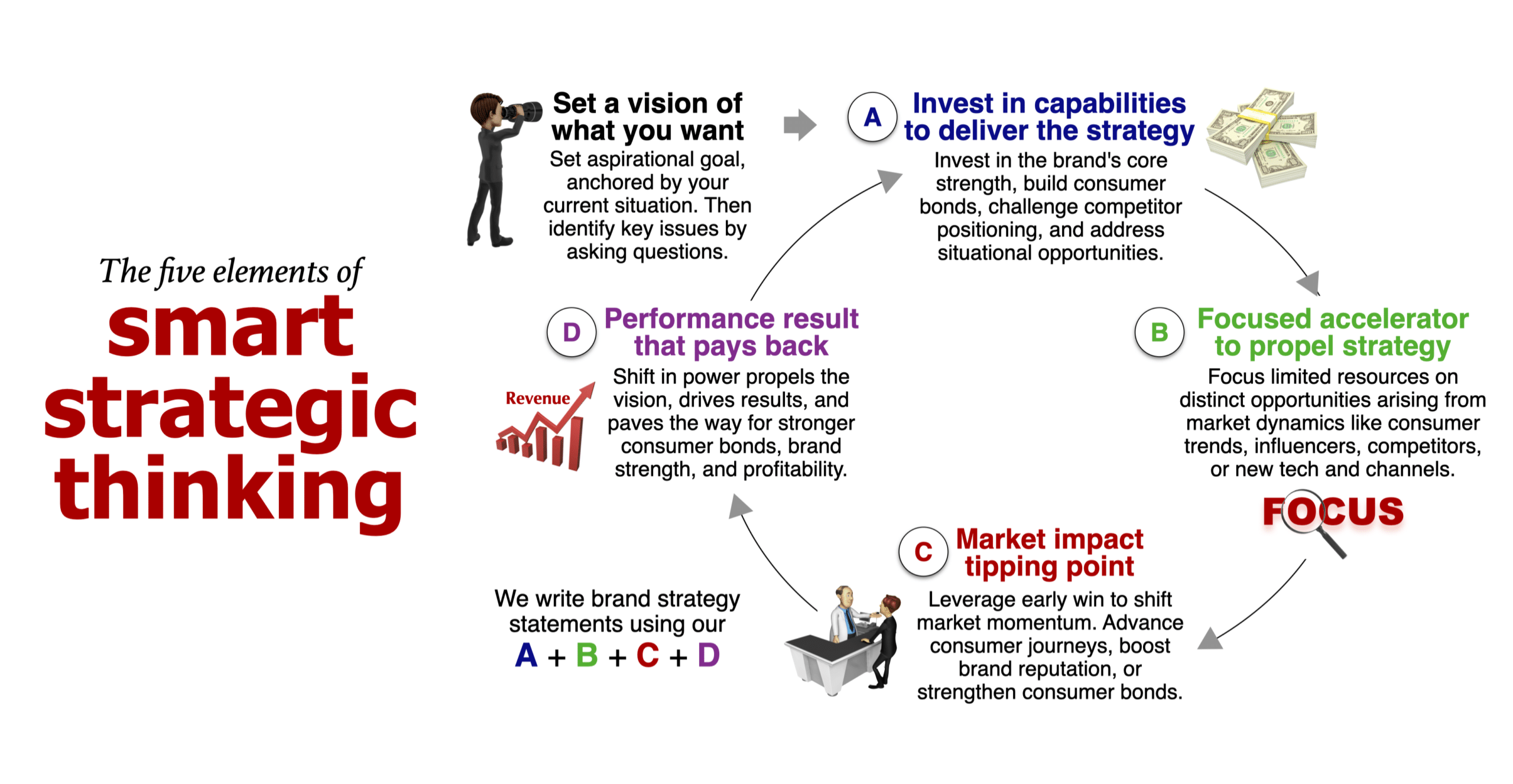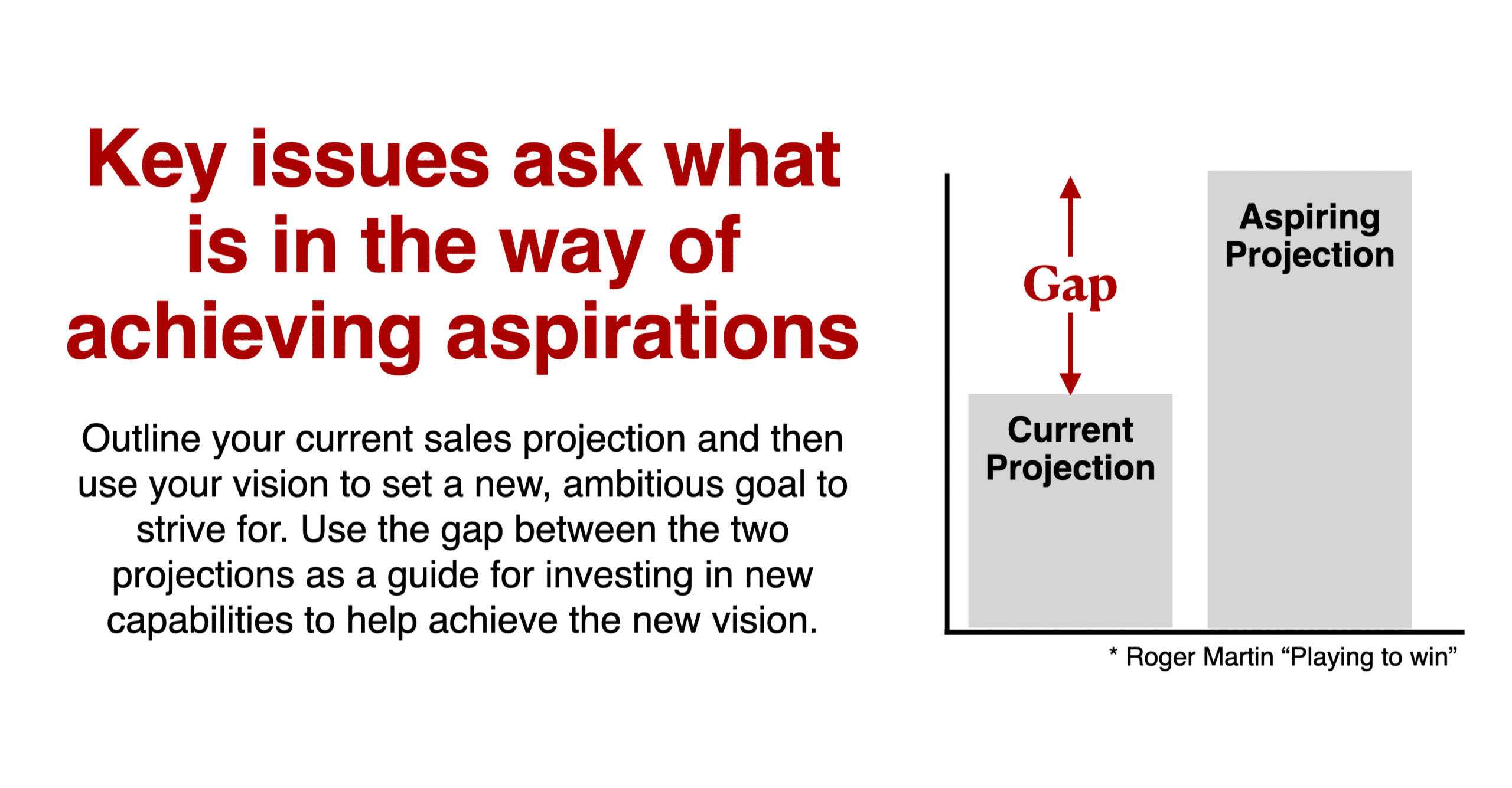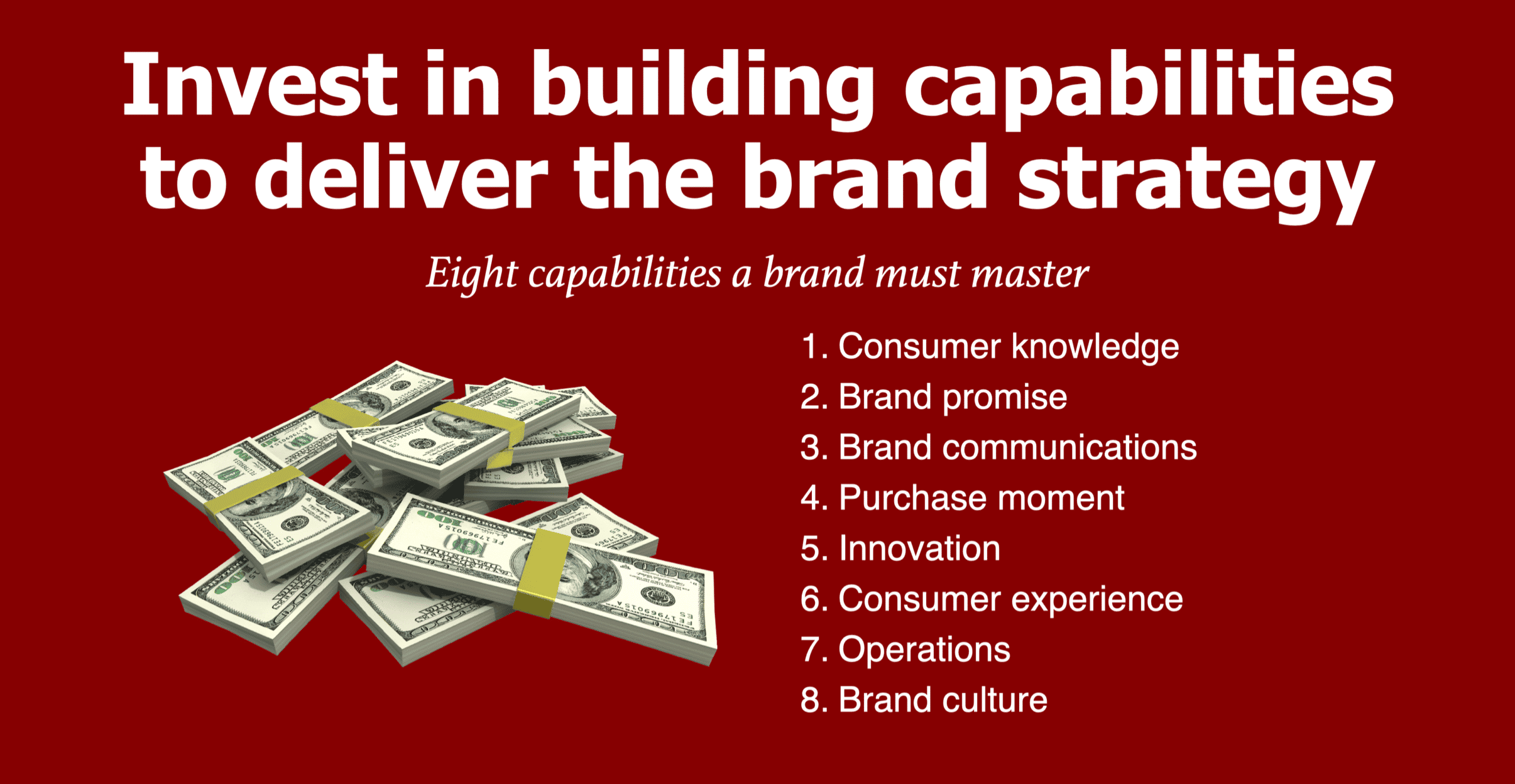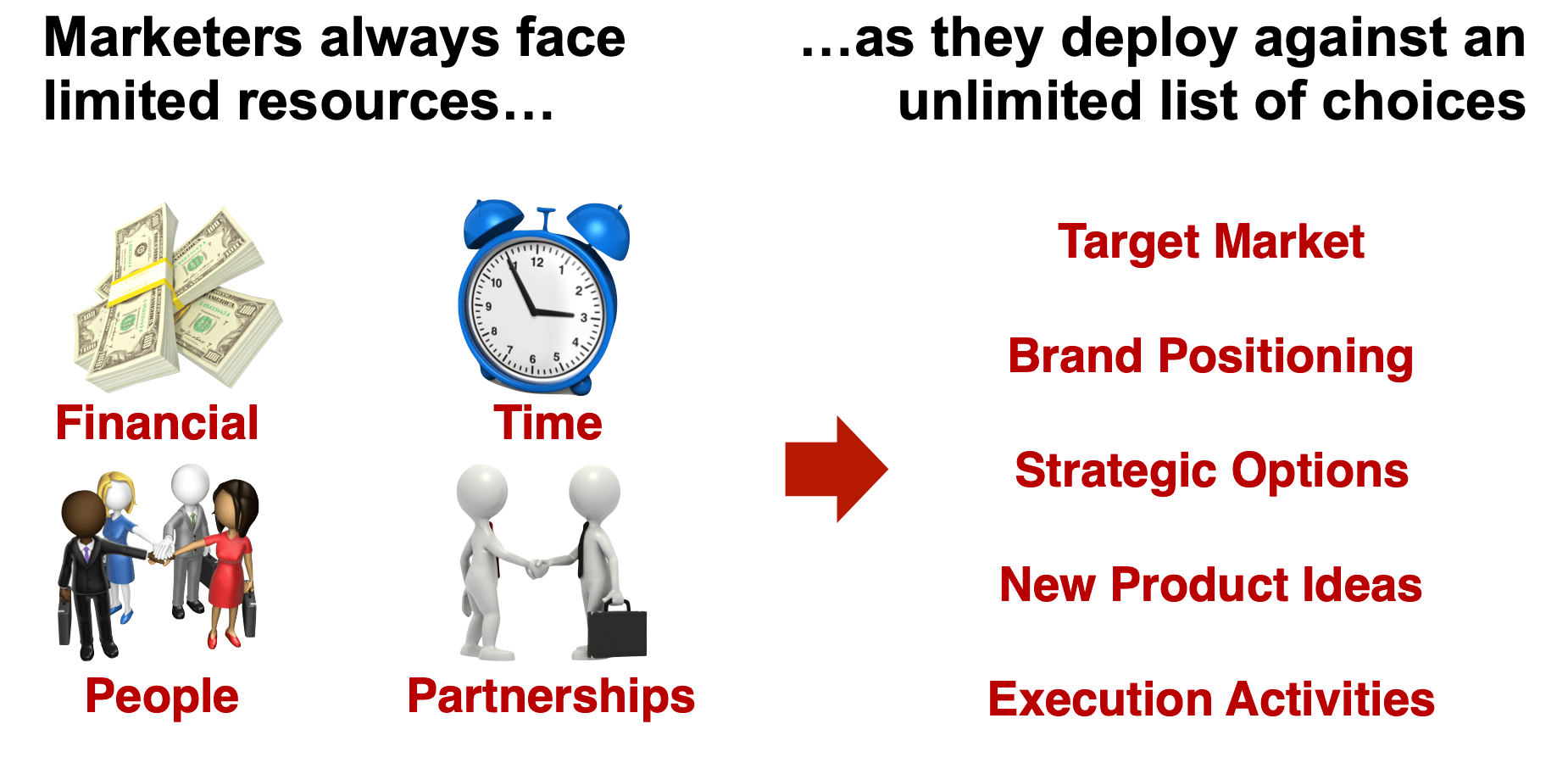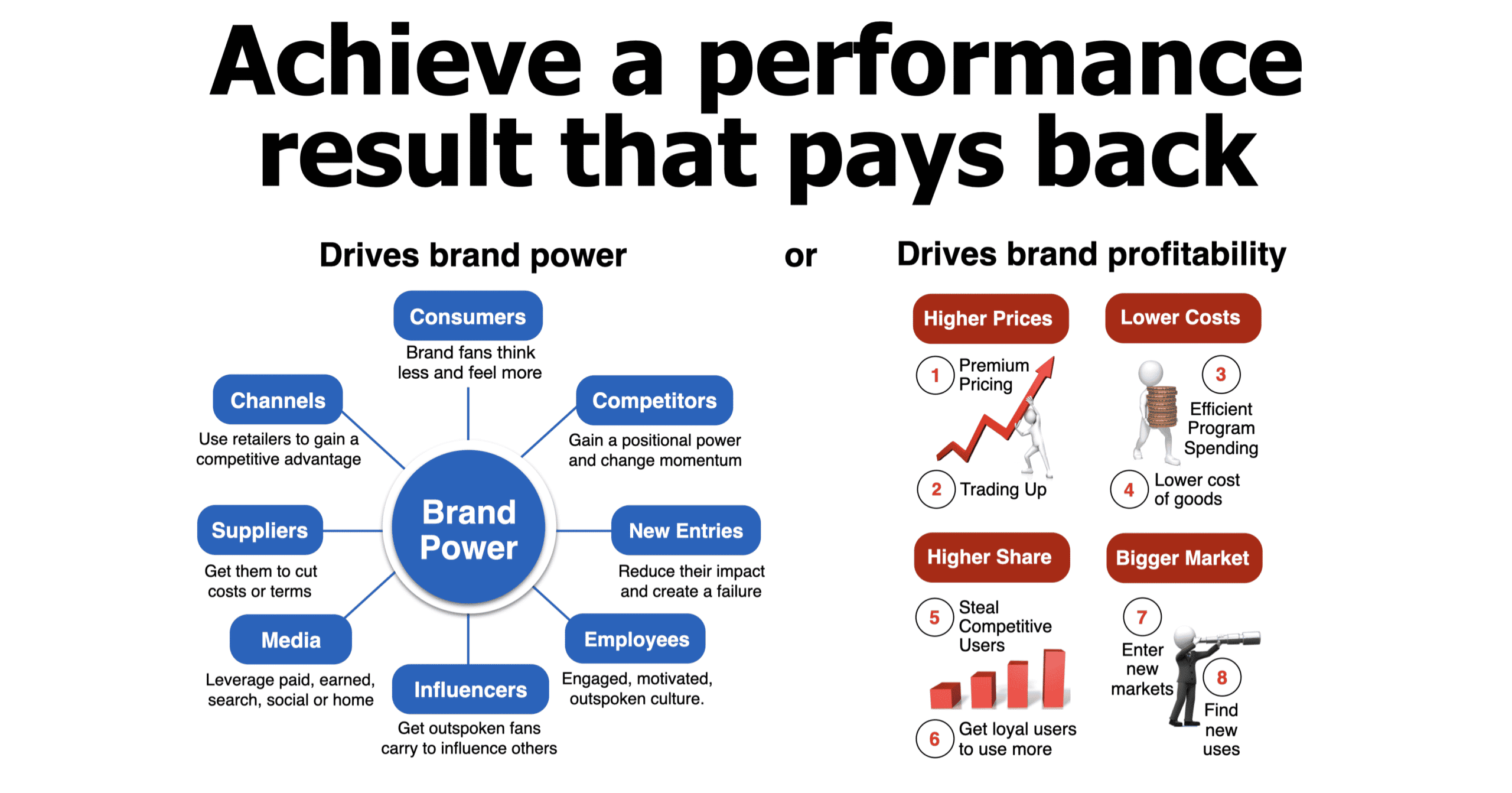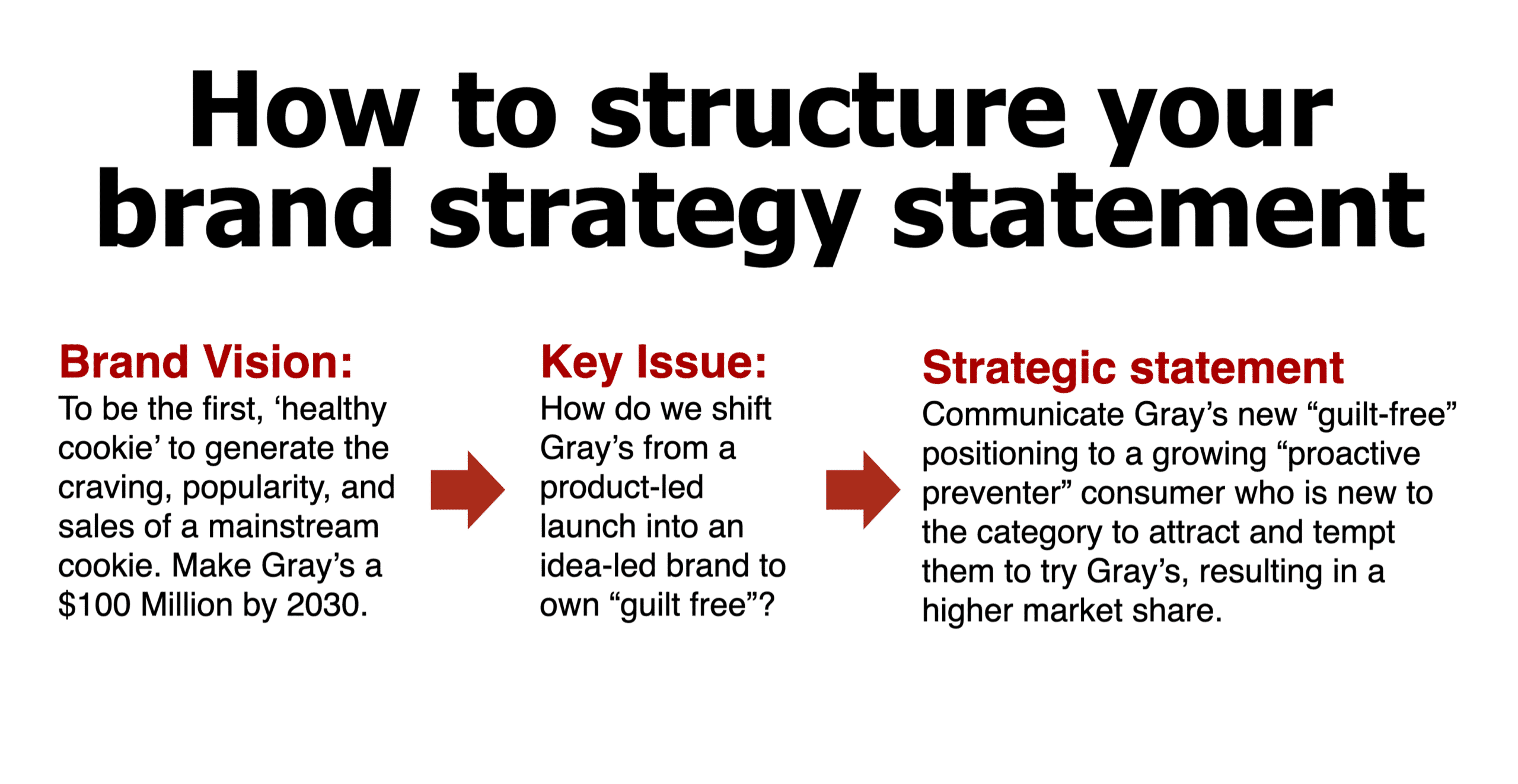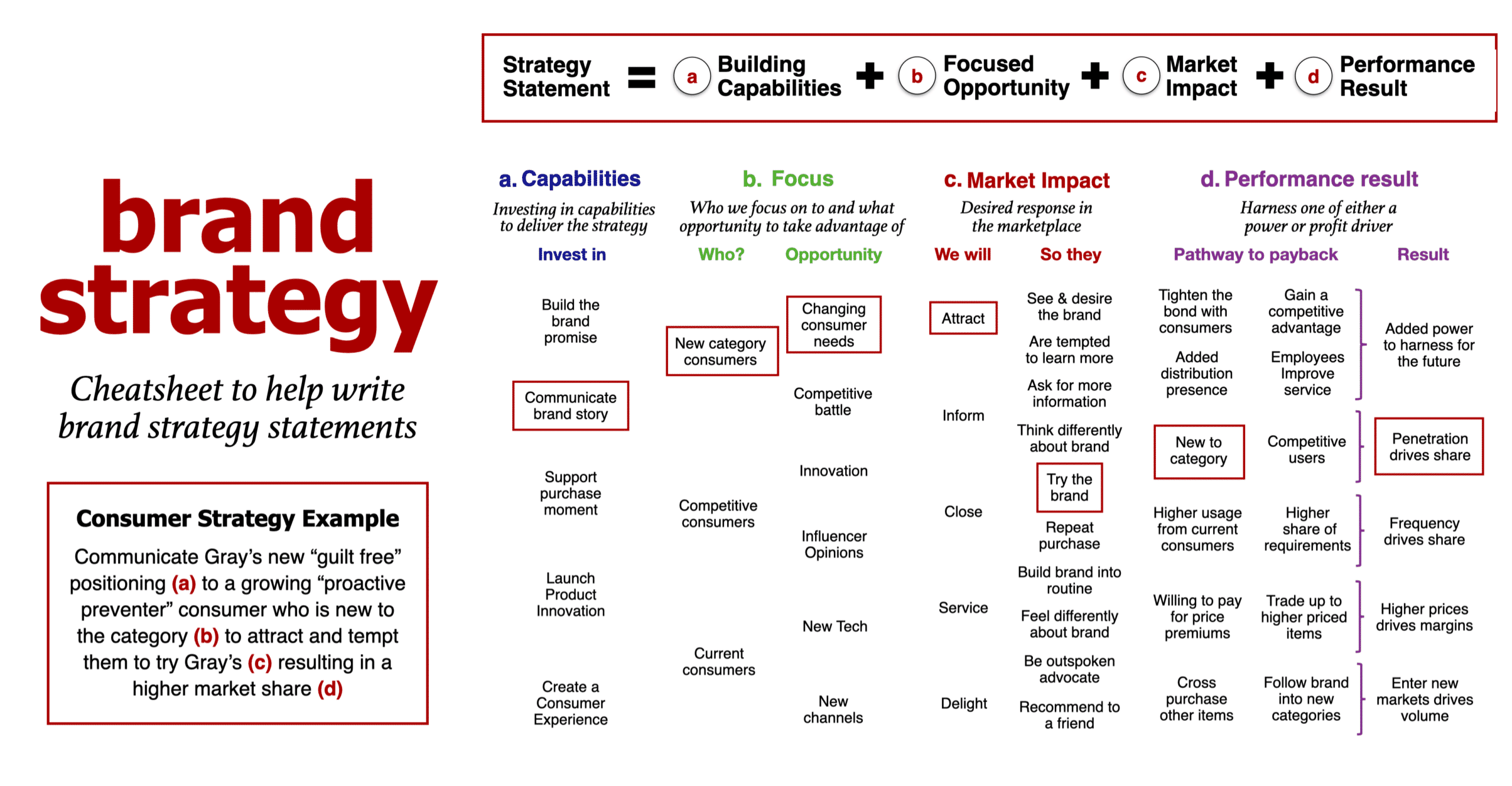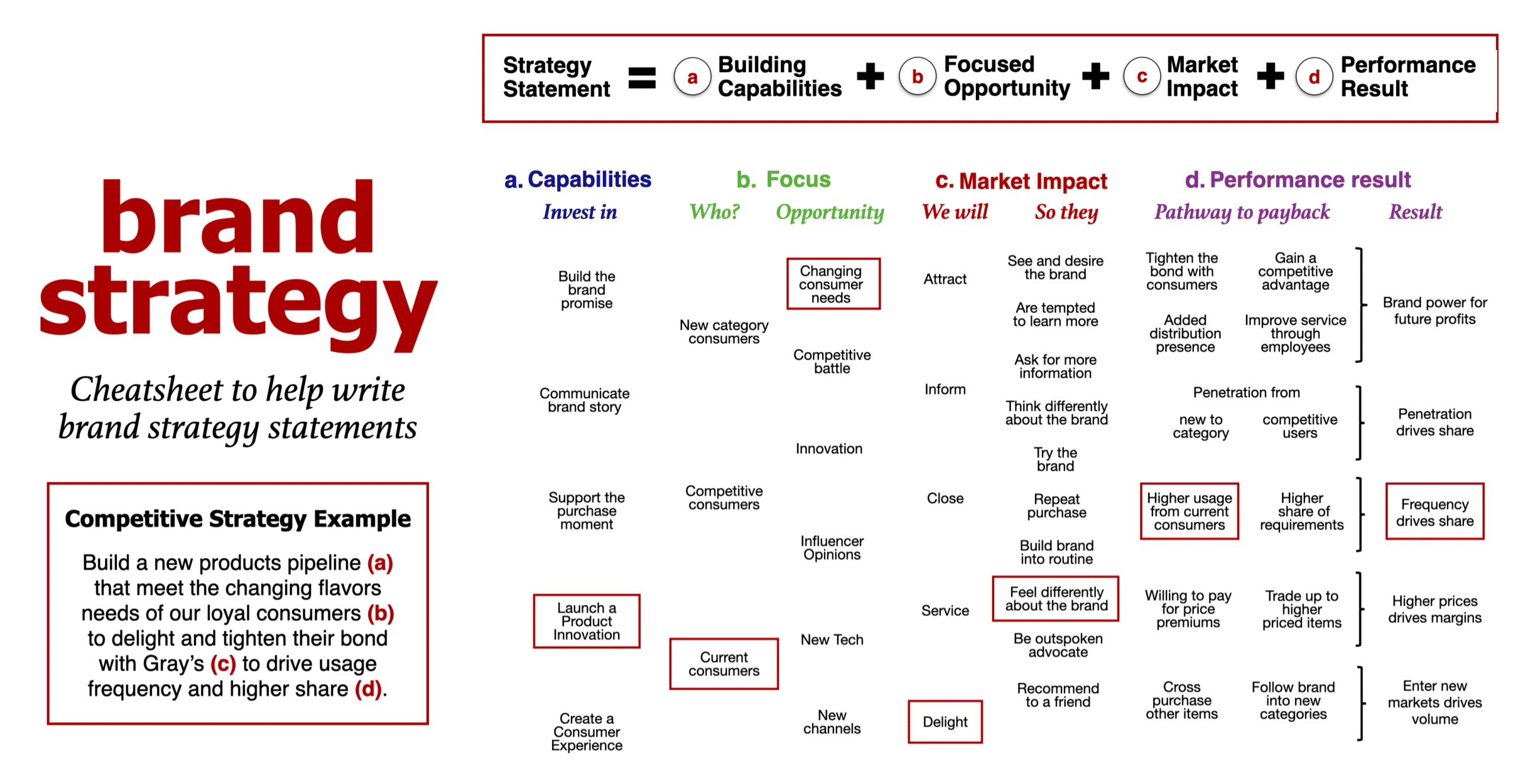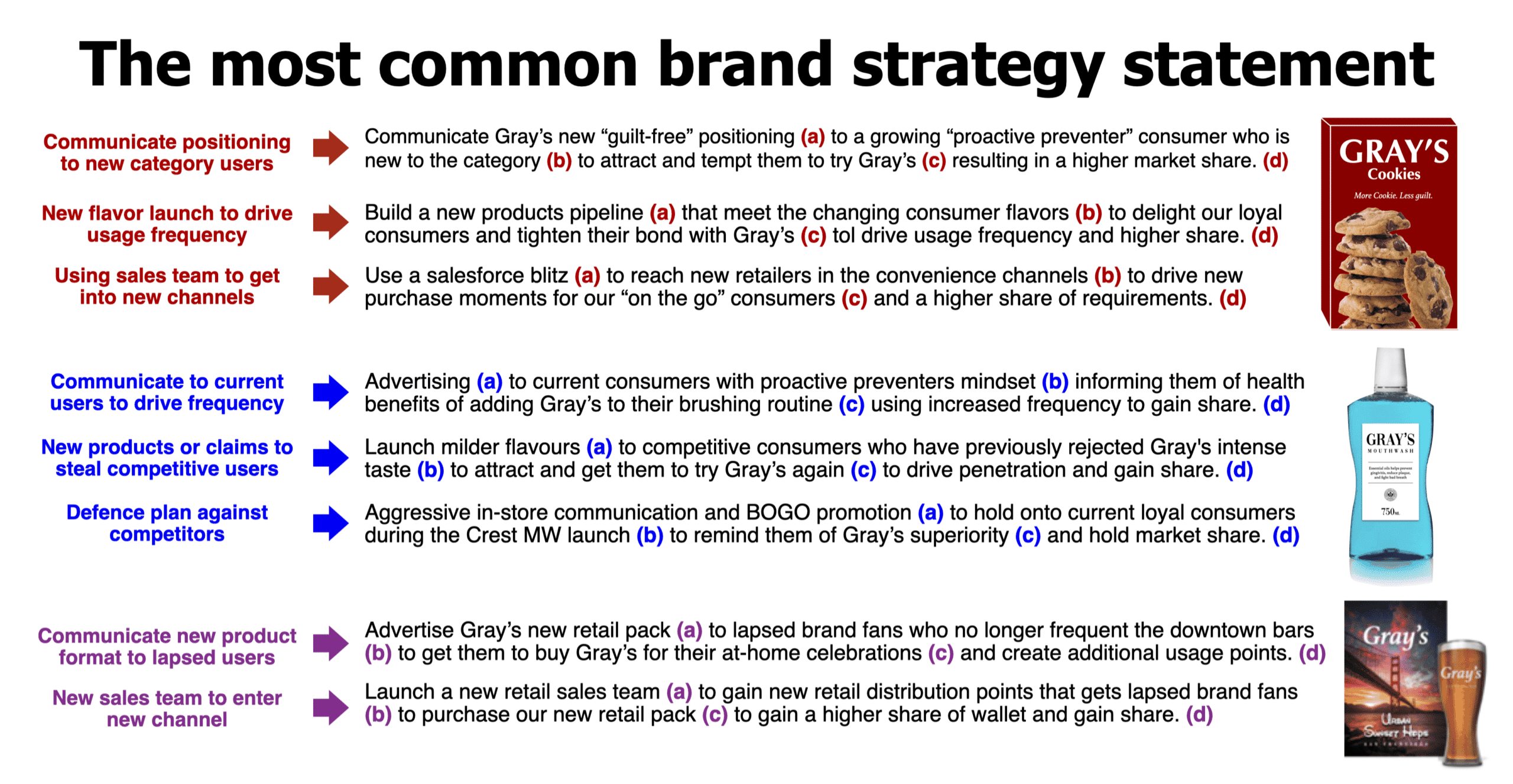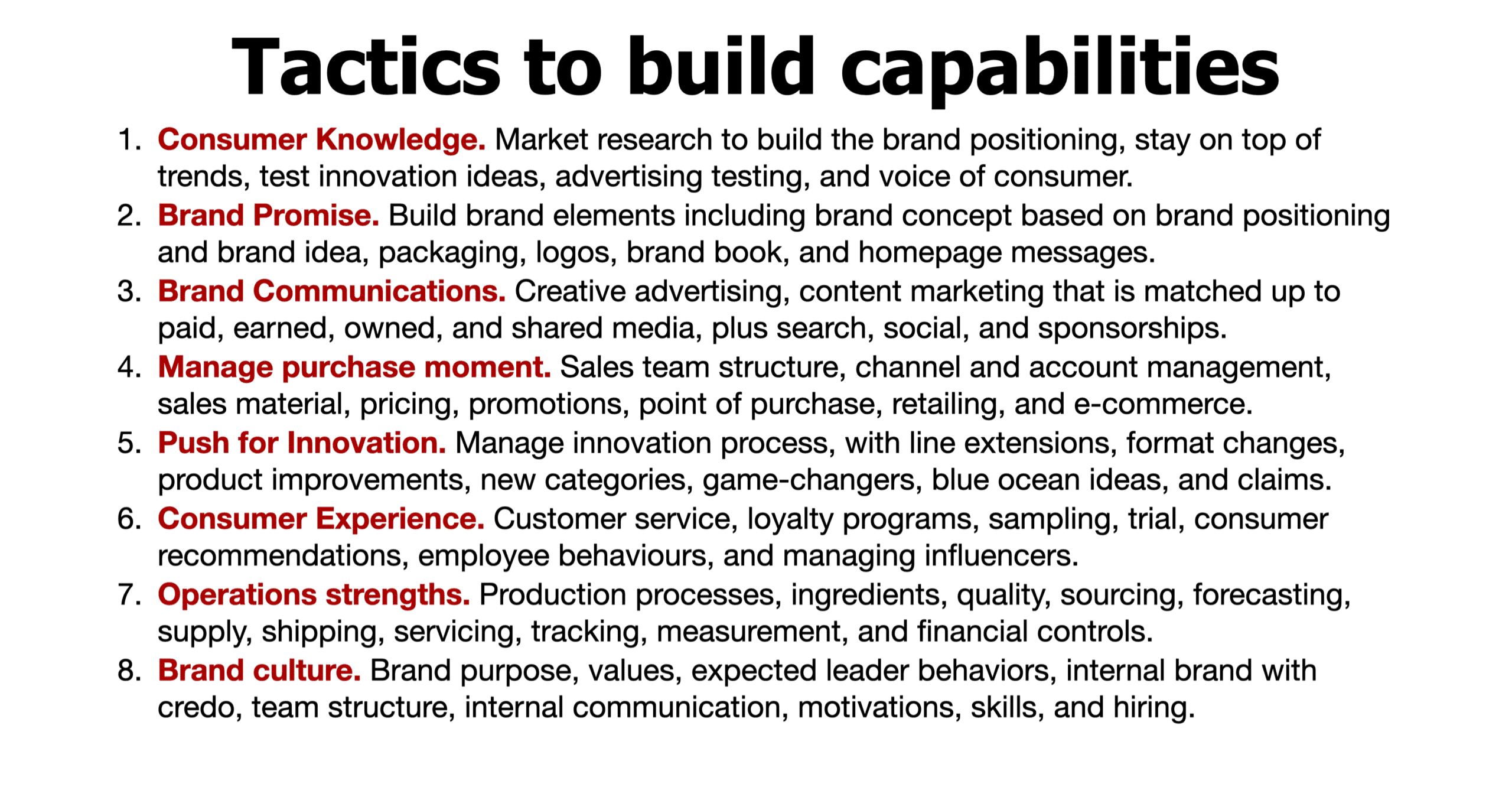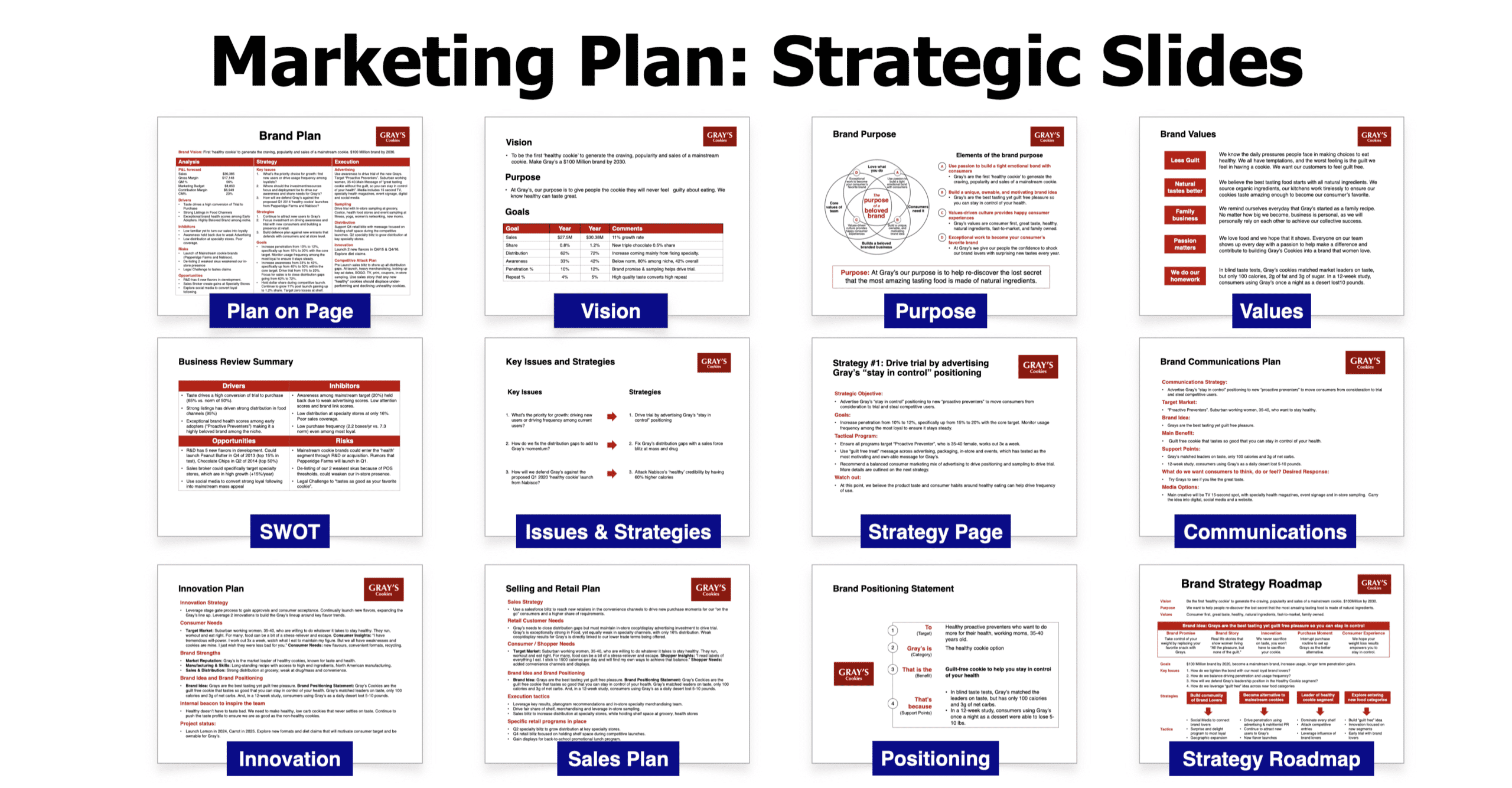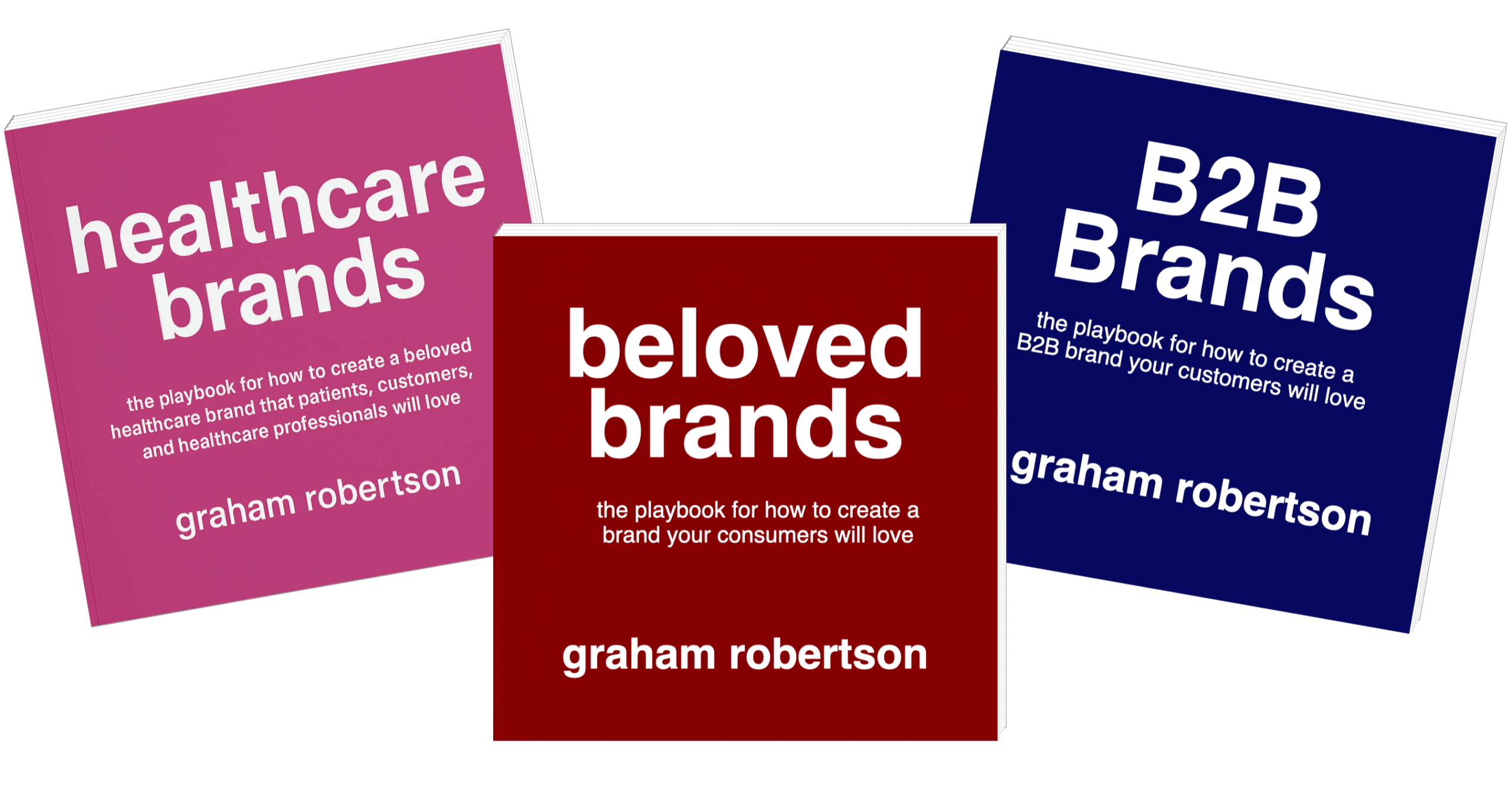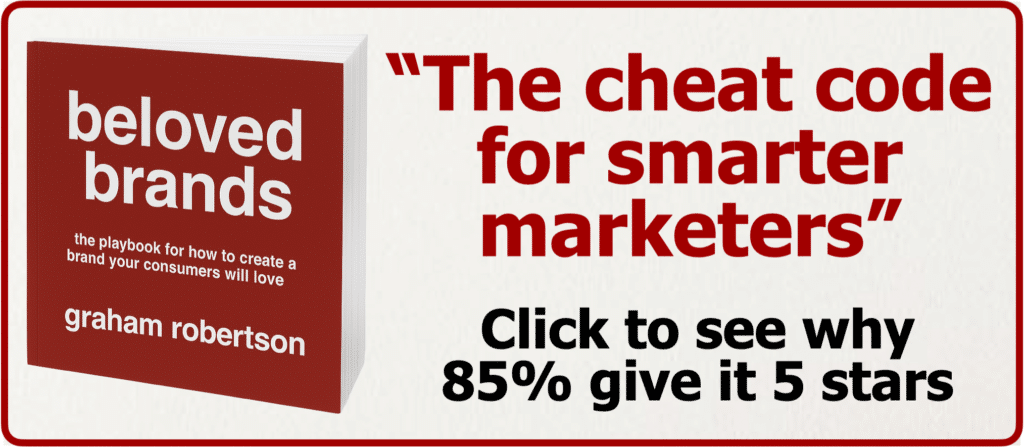When it comes to creating your marketing plan, the foundation of the plan is the vision, key issues, and smart brand strategy statements. While the vision sets the direction of where you want to go, a well-crafted brand strategy steers all marketing efforts. In this post, we will come up with the key elements of a smart brand strategy. Then, we will show how it serves as the foundation of a marketing plan. We will provide plenty of marketing plan examples and our marketing plan template. And, we show many examples of brand strategy statements.
The brand strategy statement must define the capabilities you will invest in (A). It outlines a focused accelerator that you can take advantage of which will make your investment work even harder (B). Next, the strategy must lay out the market impact (C), and the performance result (D).
Below is how you should structure your strategic thinking. From there, structure the communication of strategy through your brand strategy statements. These can be used in your marketing plan.
Are you not seeing high quality plans from your team?
If you are running a marketing team and you are not seeing high quality plans from your team, our marketing training can help. When marketers try to do too many things in their plan, none of their ideas end up with enough resources to make the impact they expect.
Marketing plans that fail to make firm decisions spread their limited resources across so many tactics that none of the ideas create a big enough impact to make a difference. With a lack of vision, the plan meanders and confuses those who work behind the scenes of the brand. At Beloved Brands, we will show how to build your plan with a brand vision, purpose, values, key issues, strategies, and execution plans.
If you want better plans from your people, our Marketing Training will help. Click on this link to learn more: Beloved Brands Marketing Training.
Five elements of smart strategic thinking
Slow down and organize our thoughts with five elements of strategic thinking. Start with the vision. Then, invest in solidifying capabilities. Find the focused accelerators already happening. Cap it off with a market impact and performance result. Below, we show a flywheel with the vision anchoring the brand strategy. Keep investing behind to keep fuelling more power and profit. .
Set a vision of what you want for your brand
A vision sets aspirational stretch goals for the future, linked to a clear result or purpose. Write a vision statement in a way that scares you a little and excites you a lot. It should steer everyone who works on the brand to focus on finding ways to create a bond with your consumers that will lead to power and profit beyond what the product alone could achieve.
As Yogi Berra famously said, “If you do not know where you are going, how will you know if you get there?” To be a visionary, you must be able to visualize the future. Imagine it is five or 10 years from now and you wake up in the most fantastic mood. Visualize a perfect future and write down the most critical milestones you need to achieve. Even think about words that will inspire, lead, and steer your team towards your vision.
Key issues define what is in the way of achieving your aspirations. Brands need look at the gap between the current trajectory and the aspiring vision you have set. We use interruptive questions that frame the issues regarding what is in the way of getting what you want to achieve. By raising those issues early on, you can focus the team on the significant problems that need to be solved on the pathway to the stated vision.
To illustrate, click on the marketing plan example above to view the key issues that set up the brand strategy.
A: Invest in building capabilities
Invest your limited resources—money, people, time, partnerships—in strategic programs that will build the capabilities to help close the gap between your current projection and the aspirational vision. From a brand viewpoint, align your investment to reinforce the brand promise, communicate the brand story, close the deal at the purchase moment, launch new product innovation, or create an ideal consumer experience.
These investments line up to deliver a brand’s consumer touchpoints so that you will tighten the bond with consumers. The result of the investment will be a more powerful, faster-growing, and profitable brand.
To illustrate, click on the capabilities to invest in that set up the brand strategy to use in our marketing plan template.
Consumer Knowledge.
Know your consumer better than your competitors know them. Focus on those who are most motivated by what you offer. Use moments of accelerated needs, enemies, and insights. Leverage data to understand what it takes to move consumers along their purchase journey.
Brand Promise.
Build brand positioning around your brand’s core strength, whether you lead with the product, story, consumer experience, or price. Combine the ideal functional and emotional benefits to create a brand idea that is unique, simple, ownable, inspiring to employees, and motivating for consumers. Use the brand idea to organize everything you do.
Brand Communications.
Use creative communications to capture attention, link to the brand, communicate the message and stick with consumers. Invest in media to attract, inform, close, service, and delight consumers, Find them at trigger points when they are most open to moving along their purchase journey.
Purchase moment.
Use skilled salespeople to inform, close and service consumers. Close gaps in regions, channels, and with important customers. Match your brand strategy to their business strategy. Optimize the customer’s tools to achieve a competitive advantage at the purchase moment.
Innovation.
Invest in continuous exploration of new products and services to stay fresh with consumers and differentiate your brand. Inspire ideas, test, and deliver. Product extensions. improvements. New formats. Brand stretching. Game-changing technology. And, blue ocean exploration.
Consumer Experience.
Alignment of the brand story that creates consumer desire with your employees’ delivery of a consumer experience that exceeds the consumer’s expectation. Operations, sales, and innovation must work together. And, each must understand their specific role in bringing the brand idea to life.
Operations strengths.
Use operations to create a competitive advantage that beats competitors based on speed, flexibility, cost, and simplicity. Build production process, ingredients, quality, sourcing, and forecasting. Work on supply, shipping, and servicing. Then, track the results. Both the financials, and measurement of goals.
Brand culture.
An internal rallying cry that reflects your brand’s purpose, values, and motivations. Inspire, challenge, and guide your people to provide their greatness on behalf of the brand. The quality of your people drives the success of your brand.
To illustrate, click on the capabilities to invest in that set up the brand strategy to use in our marketing plan template.
B: Focus on an identified accelerator to propel your strategy
Identify who you are talking to and whether you will focus on new category consumers, competitive consumers, or current consumers.
Then, look for a trend accelerator that is already happening in the market that can accelerate your strategy, whether that means you focus your limited resources on a distinct opportunity you have identified based on a potential change in market dynamics such as consumer trends, influencer opinions, competitors, new technology or channels.
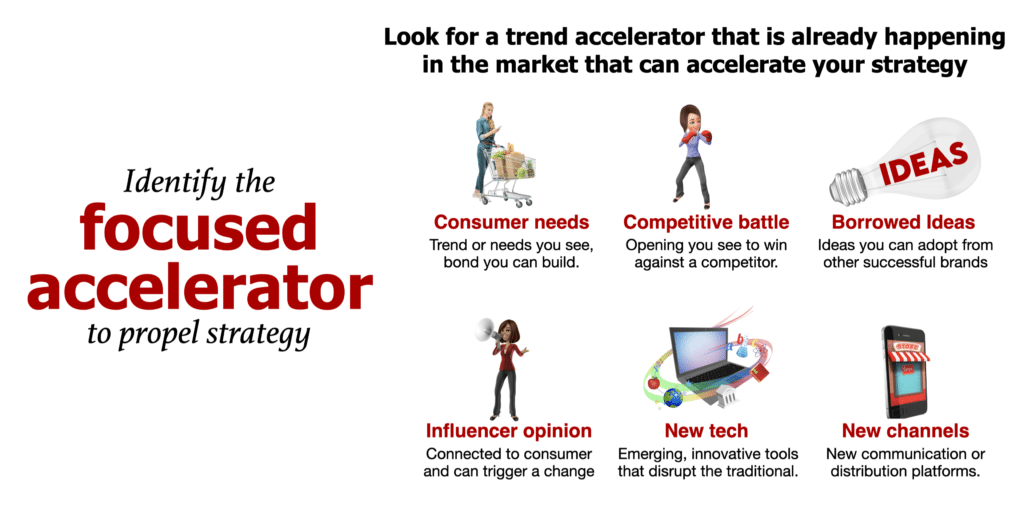
Every brand has limited financial, time, people, or partnerships resources.
Marketers always face the temptation of unlimited choices, whether in the potential target market, brand messages, strategies, or tactics. The smartest marketers limit their choices to match up to their limited resources, to focus on those that will deliver the highest return.
To illustrate, how to focus your investmennts to set up the brand strategy to use in your marketing plan.
Myth 1: The most prominent myth of marketing is to believe that your brand will get bigger if you have a broader target market.
Reality: Too many marketers target anyone. I will always argue that it is better to be loved by a few than tolerated by many. You have to create a tight bond with a core base of brand fans, and then use that fan support to expand your following.
Myth 2: The second myth to becoming a more prominent brand is to believe a brand stands for everything. Some brands try to say everything possible with the hope the consumer hears anything.
Reality: Hope is never a strategy. To be loved by consumers, a brand must stand for something with a backbone and conviction. Trying to be everything to anyone ends up becoming nothing to everyone.
Myth 3: Your brand will achieve higher sales if you try to be everywhere, whether in every sales channel or on every possible media option.
Reality: If you went to Las Vegas and put a chip on every square, you would be bankrupt before midnight. The worst marketers lack focus because they fear missing out on someone or something. By trying to be everywhere, the brand will drain itself and eventually end up being nowhere.
Every brand has limited resources, whether they are financial, time, people, or partnerships. Marketers always face the temptation of an unlimited array of choices, whether in the possible target market, brand messages, strategies, or tactics. The smartest brand leaders limit their choices to match up to their limited resources, to focus on those that will deliver the highest return.
C: Leverage a breakthrough market impact
A smart strategy turns an early breakthrough win into a shift in momentum, positional power, or tipping point where you begin to achieve more in the marketplace than the resources you put in.
Many underestimate the need for an early win. I see this as a crucial breakthrough point where you start to look at a small shift in momentum towards your vision. While there will always be doubters to every strategy, the results of the early win provide compelling proof to show everyone the plan will work. You can change the minds of the doubters—or at least keep them quiet—so everyone can stay focused on the breakthrough point.
The magic of strategy happens through leverage, where you can use the early win as an opening or a tipping point where you start to see a transformational power that allows you to make an impact and achieve results in the marketplace. A smart strategy should trigger the consumer to move along the buying journey from awareness to buy and onto loyalty, and it can help tighten the consumer’s bond with the brand.
To illustrate, click on the market impact element of the brand strategy to use in your marketing plan.
D: Achieve a performance result that pays back
The shift in positional power in the marketplace moves your brand toward your vision and creates a future pathway to building a consumer bond, brand power, and brand profitability. A brand can become powerful compared to the consumers they serve, the competitors they battle, the channels they sell through, the suppliers who make the products or ingredients, the influencers in the market, any media choices and the employees who work for the brand.
You can drive profit through premium pricing, trading consumers up on price. Find a lower cost of goods, or use lower sales and marketing costs. Steal competitive users, or get loyal users to use more. Enter new markets or find new uses for the brand. We explore these eight ways a brand can add to their profitability. For a strategy to work, what pays off in the marketplace must pay off in brand power or business results.
To illustrate, click on the performance result element of the brand strategy to use in your marketing plan.
Take your brand knowledge to new heights with our Beloved Brands playbook
Beloved Brands is a comprehensive guide that covers the fundamentals of brand management. It goes deep on strategic thinking, brand positioning, brand plan development, advertising decisions, media planning, marketing analytics, and the brand financials. This is an opportunity to build your marketing skills to help your career. Moreover, it will provide you with the roadmap for driving growth on your brand. We go through our marketing plan template. And, we have plenty of marketing plan examples in our book.

Marketers see Beloved Brands playbook as a go-to resource, as they keep it within arm’s reach for any new project. We are thrilled to see that it has received a 5-star rating from nearly 90% of Amazon reviewers. Additionally, we have also created playbooks for B2B Brands and Healthcare Brands, catering to specific industries.
Using Gray's Cookies to demonstrate strategic thinking
We will use the fictional Gray’s Cookies as a case study to lead us to a marketing plan example. Gray’s Cookies are the ultimate healthy cookie, which is excellent tasting, low fat, low calorie and made from the best ingredients. I did mention it was fictional. This cookie is battling the major mainstream competitors, starting from a small niche with a core target market of fans who are beginning to love the brand. At the end of this post, we will show you our fully completed marketing plan example using Gray’s.

Five elements of smart strategic thinking for the fictional Gray’s Cookies brand:
1. Set a vision of what you want
Gray’s wants to be the first healthy cookie to generate the craving, popularity, and sales of a mainstream cookie. In this marketing plan example, the company wants to make Gray’s a $100 million brand by 2022. Like many new brands, is how to drive trial while closing gaps.
2. Invest resources in solidifying your capabilities to deliver the vision
At rapid growth stage, Gray’s needs to invest in building a strong bond with consumers, address distribution gaps while battling mainstream brands who could enter the healthy cookie segment.
3. Focus on an identified opportunity
Gray’s Cookies recognizes the opportunity created by the consumer shift to healthy choices. If they can take the dominant power player role in the healthy cookie segment, they can drive a high market share in a rapid growth category segment.
4. Leverage a breakthrough market impact
In this marketing plan example, Gray’s Cookies is the dominant power player role in driving high trial, and significant market share results to gain additional shelf space in the retail stores.
5. Achieve a performance result that pays back
Gray’s will bring mainstream cookie users over to drive higher sales and establish itself as the dominant “healthy cookie” brand.
Ideal structure for your strategy statement
Let’s now look at how to turn your smart strategic thinking into writing a brand strategy statement that can provide specific marching orders to everyone who works on the brand. The vision is the aspirational target five to ten years from now. And, the key issue looks at the gap between the aspiration and current projection, and asks what is in the way. Finally, the brand strategy statement then answers the key issue.
To illustrate, click on the marketing plan example and examples of brand strategy statement.
We want our process to cover all five elements of smart strategic thinking. Above, you can see the brand vision, and key issue statement we came up with through our Strategic ThinkBox. This covers the first strategic element. Next, you need a strategy statement to cover the remaining four other strategic elements, including the program investment, focused opportunity, market impact, and the performance result.
Here’s how that brand strategy statement includes all four remaining elements:
A: Build capabilities to deliver the vision:
The investment in a capabilities to deliver the strategy whether building the brand promise, brand story, purchase moment, product innovation and consumer experience. These crystal clear marching orders to the team leave no room for doubt, confusion, or hesitation. In the example of brand strategy above, the strategic program is to “Communicate Gray’s new “guilt-free” positioning.”
B: Focused opportunity:
The breakthrough point where the brand will exert pressure to create a market impact. In this example of brand strategy, the focused opportunity is the “to a growing “proactive preventer” consumer who is new to the category.”
C: Market impact:
Achieves a specific desired market impact with a stakeholder you will attempt to move, whether it is consumers, sales channels, competitors, or influencers. In this example of brand strategy, the desired impact is to “attract and tempt them to try Gray’s”
D: Performance result:
Drive a specific performance result linked to the market impact, either making the brand more powerful or more profitable. In this example of brand strategy, “resulting in a higher market share.”
Turn your thinking into brand strategy statements
Our unique strategic model will force you to pick answers to build a strategy statement with marching orders for those who follow your plan. As you build your brand plan, I recommend you use these four elements of smart strategy statements to ensure you structure and demonstrate your great thinking.
Writing your brand strategy statements
The strategies in the brand plan answer, “How can we get there?” Each strategy must provide a clear, definitive answer to each of your key issues.
When I was in business school, I had a marketing professor who would say 15 times per class, “It is all about choices. It is all about choices.”
The marketing plan is a great tool to force you to make tough decisions, as you apply your brand’s limited resources of dollars, time, people, and partnerships against an unlimited number of choices. It is easy to get distracted by more and more options.
However, brand leaders must use the brand plan process to limit their choices down to those that move your brand along the pathway towards your stated brand vision. Choose the strategic options that provide the highest return on effort (ROE) or the highest return on investment (ROI).
Brand Strategy Cheatsheet
Here is a cheatsheet to help you write your brand strategy statements. Start by investing in capabilities, whether that delivering the brand promise, brand story, purchase moment, product innovation, or consumer experience. And who will you target? Choose your focused opportunity. For the market impact, will you attract, inform, close, service or delight consumers. What do you want them to do? For performance result, choose one of four ways to get more powerful or wealthier, by pushing penetration, frequency, pricing or enter new markets.
Below, you can see how we use the Brand Strategy Cheatsheet for consumer strategy:
To illustrate, click on the brand strategy cheatsheet to write the strategy for your marketing plan template
- A: In this consumer strategy example, the capability I will focus on is communicating the brand story. In this case, I will build on Gray’s Cookies “guilt free” positioning.
- B: Then I will choose to focus on consumers who are new to the category. There is a group of consumers called “proactive preventers” and I will take advantage of their consumer needs.
- C: The marketing tactic will focus on attracting consumers with the desired market impact of moving them to try Gray’s cookies.
- D: Finally, I can use these new to category consumers to help build the market share for Gray’s.
Putting this example of brand strategy statement together
Communicate Gray’s new “guilt free” positioning (a) to a growing “proactive preventer” consumer who is new to the category (b) to attract and tempt them to try Gray’s (c) resulting in a higher market share (d)
For our second example, we use the Brand Strategy Cheatsheet for competitive strategy:
To illustrate, click on the brand strategy cheatsheet to write the strategy for your marketing plan template
- A: In this competitive strategy example, the capability I will focus on in building a new product pipeline.
- B: I will use my consumer strategy (first strategy) to attract consumers, but in this case, I’m going to focus on current consumers, and offer them more variety options.
- C: These new products will delight my consumer so they feel differently, in this case creating a desired impact of a deeper loyalty to the brand.
- D: Finally, the expected performance result will be to drive usage frequency that will lead to a higher market share.
Putting this brand strategy statement together
Build a new products pipeline (a) that meet the changing flavors needs of our loyal consumers (b) to delight and tighten their bond with Gray’s (c) to drive usage frequency and higher share (d).
Using the consumer and competitive strategies above, I can use marketing communication to attract new consumers and product innovation to keep those consumers and build loyalty and share of wallet. Together, these two strategic investments can lead to a higher market share.
Brand Strategy Statement
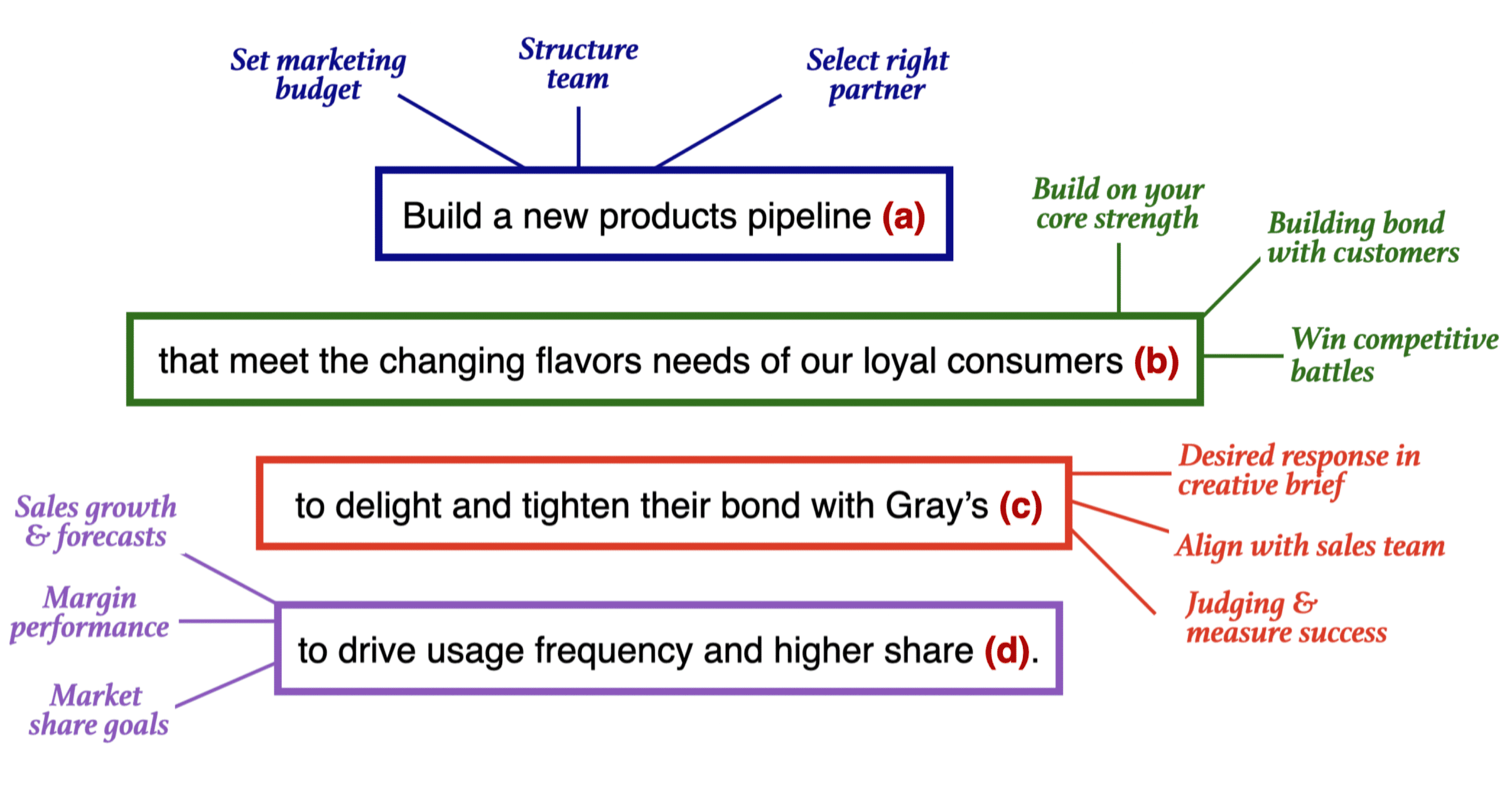
To illustrate, click on the examples of brand strategy structure to use in to writing the strategy for your marketing plan.
We can run our brand using these type of statements in our marketing plan
For (a), I can decide on how to allocate resources, to determine what financial investment or people needed to build up the capability. Lay out the people investment whether that’s a team structure to deliver the capability or the partner to select.
For (b), the focus will be matched up to our brand’s core strengths, the relationship with our customers, or what competitive battles we face.
For (c), the market impact should be at the top of a creative brief or goals with sales, or go straight into the goals of the teams who work on the brands.
Finally, (d) helps us map out the expected performance result, whether that’s managing the sales forecast, the P&L or the market share goals.
Aligning to the marketing plan
An annual marketing plan should build around 3 of these type of brand strategy statements. The long-range strategic plan should have a five year window and can handle up to 5 of these strategy statements. I like to ensure we have a balance of statements, with one consumer strategy, one competitive, and one that relates to either the brand’s core strength, or the situational strategy.
As you move to the execution plans within your marketing plans, now is the time to cascade your strategies down to those who work behind the scenes of the brand. Below, you can find various tactics that will help build up the capabilities related to: consumer knowledge, brand promise, communications, purchase moment, innovation, consumer experience, operations, and the culture.
To illustrate, click on the brand capabilities to invest in for your marketing plan.
Our Brand Strategy statements work for B2B Brands

To illustrate, click on the examples of brand strategy structure to use in to writing the strategy for your marketing plan.
Our Brand Strategy statements work for B2B Brands

To illustrate, click on the healthcare examples of brand strategy to use in our marketing plan template.

To illustrate, click on the marketing plan example above to see how it all comes together in our marketing plan template.
Read our Marketing Plan Blueprint post:
As a seasoned marketing leader, I have seen firsthand the power of a well-crafted marketing plan. First, you need to get your plan approved by your boss. Second, you need all stakeholders to know their specific role in delivering the plan.
A comprehensive plan not only sets clear vision, purpose and goals for your brand. We also provide a step-by-step roadmap for execution.
In this article, I will walk you through my proven process for developing a winning marketing plan. We use real-world marketing plan examples and my own marketing plan template. I will guide you through the the analysis needed to discover the key issues facing your brand. And, I will show how to write structured brand strategy statements that are the foundation of a great plan. We show plenty of examples of brand strategy.
Marketing Plan template
Our Marketing Plan template is a comprehensive solution that goes beyond the brand plan, providing a wide range of marketing execution slide options.
Elevate your marketing strategy with our comprehensive Marketing Plan template. This template includes over 30 strategically designed slides to effectively communicate your brand vision, purpose, key issues, and strategies for the organization.
Additionally, our marketing plan template provides a wide range of marketing execution slides covering:
- Advertising.
- Social media.
- Search.
- Event marketing.
- Sampling.
- New product launches.
- Customer marketing.
- In-store merchandising.
- Promotion slides.
And, our marketing plan template includes a fully completed Marketing Plan example.
To illustrate, click on the marketing plan example above to see how the Marketing Plan template comes together.
Click on the marketing plan example above to see how the Marketing Plan template slides come together.
